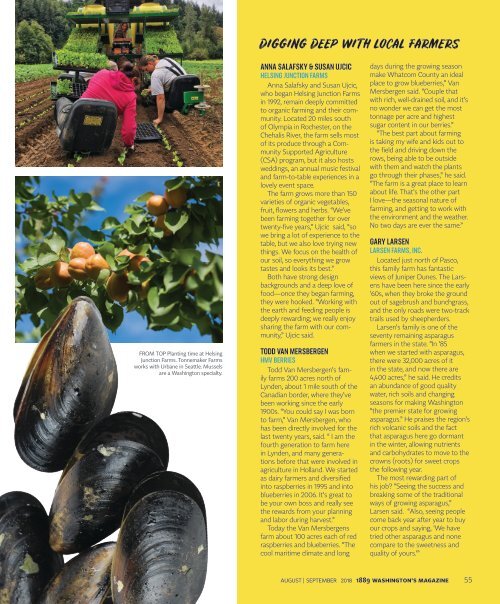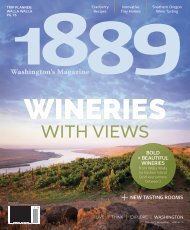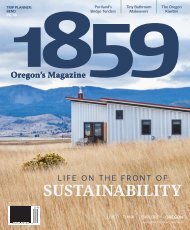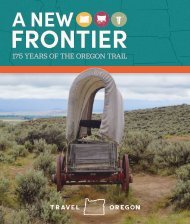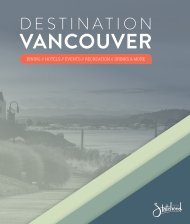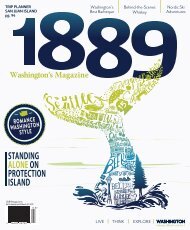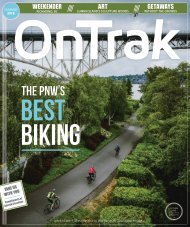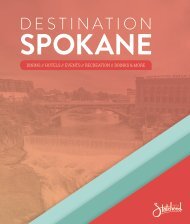1889 August | September 2018
Create successful ePaper yourself
Turn your PDF publications into a flip-book with our unique Google optimized e-Paper software.
DIGGING DEEP WITH LOCAL FARMERS<br />
FROM TOP Planting time at Helsing<br />
Junction Farms. Tonnemaker Farms<br />
works with Urbane in Seattle. Mussels<br />
are a Washington specialty.<br />
ANNA SALAFSKY & SUSAN UJCIC<br />
HELSING JUNCTION FARMS<br />
Anna Salafsky and Susan Ujcic,<br />
who began Helsing Junction Farms<br />
in 1992, remain deeply committed<br />
to organic farming and their community.<br />
Located 20 miles south<br />
of Olympia in Rochester, on the<br />
Chehalis River, the farm sells most<br />
of its produce through a Community<br />
Supported Agriculture<br />
(CSA) program, but it also hosts<br />
weddings, an annual music festival<br />
and farm-to-table experiences in a<br />
lovely event space.<br />
The farm grows more than 150<br />
varieties of organic vegetables,<br />
fruit, flowers and herbs. “We’ve<br />
been farming together for over<br />
twenty-five years,” Ujcic said, “so<br />
we bring a lot of experience to the<br />
table, but we also love trying new<br />
things. We focus on the health of<br />
our soil, so everything we grow<br />
tastes and looks its best.”<br />
Both have strong design<br />
backgrounds and a deep love of<br />
food—once they began farming,<br />
they were hooked. “Working with<br />
the earth and feeding people is<br />
deeply rewarding; we really enjoy<br />
sharing the farm with our community,”<br />
Ujcic said.<br />
TODD VAN MERSBERGEN<br />
HMV BERRIES<br />
Todd Van Mersbergen’s family<br />
farms 200 acres north of<br />
Lynden, about 1 mile south of the<br />
Canadian border, where they’ve<br />
been working since the early<br />
1900s. “You could say I was born<br />
to farm,” Van Mersbergen, who<br />
has been directly involved for the<br />
last twenty years, said. “ I am the<br />
fourth generation to farm here<br />
in Lynden, and many generations<br />
before that were involved in<br />
agriculture in Holland. We started<br />
as dairy farmers and diversified<br />
into raspberries in 1995 and into<br />
blueberries in 2006. It’s great to<br />
be your own boss and really see<br />
the rewards from your planning<br />
and labor during harvest.”<br />
Today the Van Mersbergens<br />
farm about 100 acres each of red<br />
raspberries and blueberries. “The<br />
cool maritime climate and long<br />
days during the growing season<br />
make Whatcom County an ideal<br />
place to grow blueberries,” Van<br />
Mersbergen said. “Couple that<br />
with rich, well-drained soil, and it’s<br />
no wonder we can get the most<br />
tonnage per acre and highest<br />
sugar content in our berries.”<br />
“The best part about farming<br />
is taking my wife and kids out to<br />
the field and driving down the<br />
rows, being able to be outside<br />
with them and watch the plants<br />
go through their phases,” he said.<br />
“The farm is a great place to learn<br />
about life. That’s the other part<br />
I love—the seasonal nature of<br />
farming, and getting to work with<br />
the environment and the weather.<br />
No two days are ever the same.”<br />
GARY LARSEN<br />
LARSEN FARMS, INC.<br />
Located just north of Pasco,<br />
this family farm has fantastic<br />
views of Juniper Dunes. The Larsens<br />
have been here since the early<br />
’60s, when they broke the ground<br />
out of sagebrush and bunchgrass,<br />
and the only roads were two-track<br />
trails used by sheepherders.<br />
Larsen’s family is one of the<br />
seventy remaining asparagus<br />
farmers in the state. “In ’85<br />
when we started with asparagus,<br />
there were 32,000 acres of it<br />
in the state, and now there are<br />
4,400 acres,” he said. He credits<br />
an abundance of good quality<br />
water, rich soils and changing<br />
seasons for making Washington<br />
“the premier state for growing<br />
asparagus.” He praises the region’s<br />
rich volcanic soils and the fact<br />
that asparagus here go dormant<br />
in the winter, allowing nutrients<br />
and carbohydrates to move to the<br />
crowns (roots) for sweet crops<br />
the following year.<br />
The most rewarding part of<br />
his job? “Seeing the success and<br />
breaking some of the traditional<br />
ways of growing asparagus,”<br />
Larsen said. “Also, seeing people<br />
come back year after year to buy<br />
our crops and saying, ‘We have<br />
tried other asparagus and none<br />
compare to the sweetness and<br />
quality of yours.’”<br />
AUGUST | SEPTEMBER <strong>2018</strong> <strong>1889</strong> WASHINGTON’S MAGAZINE 55


